Citadel of Château-d'Oléron
| Citadelle du Château-d'Oléron | |
|---|---|
| Le Château-d'Oléron, Charente-Maritime, Nouvelle-Aquitaine in France | |
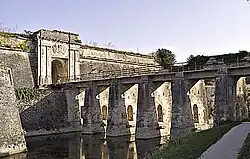 The fixed bridge of the Royal Gate | |
| Site information | |
| Type | Citadel |
| Owner | Commune |
| Condition | Fortified place |
| Location | |
| Coordinates | 45°53′09″N 1°11′41″W / 45.8858333333333°N 1.19472222222°W |
| Site history | |
| Built | 1630–1704 |
| Architect | Pierre d'Argencour, Louis Nicolas de Clerville, François Ferry (under Vauban's supervision) |
The Citadel of Château-d'Oléron is a military fortress constructed between 1630 and 1704 to safeguard the southern part of the Île d'Oléron in the Charente-Maritime department of southwestern France. It stands as one of the principal historic monuments in the town of Le Château-d'Oléron.
Originally built to replace a dilapidated medieval castle, the citadel was commissioned by Cardinal Richelieu in 1630 and later modernized by the renowned military engineer Vauban. It became a critical component of the Atlantic coast's defense system and served as a key training and embarkation point for soldiers bound for New France. During the Reign of Terror and again in 1870, it functioned as a prison. Classified as a historic monument in 1929, the citadel was occupied by German forces in 1940 and damaged during an Allied bombing on 17 April 1945.[1]
History
Medieval fortifications
The site of the current citadel was likely fortified as early as the 11th century. In the 12th century, a castle belonging to the Dukes of Aquitaine hosted Eleanor of Aquitaine. Following her visit, she issued the Rôles d'Oléron, one of the earliest maritime law codes. The stronghold was contested during conflicts between French and Anglo-Aquitainian forces. Part of the English-aligned Duchy of Aquitaine, the Île d'Oléron became permanently French in the 15th century.[2]
Modern fortifications
During the French Wars of Religion, the castle was a focal point of conflict between Huguenot and Catholic forces. In 1586, Protestant troops led by Agrippa d'Aubigné seized the castle and the island. The Catholic governor of Brouage, François d'Espinay de Saint-Luc, responded with a force of several thousand, including 400 arquebusiers, 200 pikemen, 50 musketeers, and garrisons from Brouage and Saintes. The castle was swiftly recaptured, and d'Aubigné was imprisoned.[3]
By 1625, the castle's vulnerability was evident, prompting Cardinal Richelieu to commission engineer Pierre d'Argencour to build a bastioned fortress east of the medieval site. This triangular structure, with two bastions facing the town, formed the citadel's core. Louis XIV visited in 1660, but the fortress was deemed inadequate, leading Colbert to task Louis Nicolas de Clerville with upgrades, including an ocean-facing bastioned front, a decision criticized by contemporaries.[4]
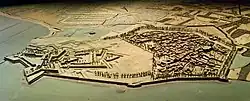
In 1685, Vauban inspected the fortifications, noting their weaknesses. He proposed two hornworks, one facing the town and another the marshes. Construction began urgently in 1688 during the War of the League of Augsburg, employing nearly 7000 workers, including requisitioned peasants.[5] Much of the medieval town, including two churches and a convent, was demolished. Harsh conditions in the winter of 1689–1690 led to many worker deaths. A bastion collapsed shortly after completion, replaced by a demi-lune. A formal labor recruitment campaign followed, attracting local salt workers.[6]
In 1691, Vauban expanded the citadel with new bastioned towers, a counterguard, and covered ways, requiring further expropriations and demolitions. A glacis was added in 1695, and a new town with a grid layout and modern walls was begun in 1699. Construction halted in 1704.[6]
The citadel housed a garrison for coastal defense and served as a staging point for troops bound for New France. From 1710 to 1716, Acadia garrison soldiers trained there, followed by Louisiana company members in 1716 and Quebec-bound troops in 1720. A new port was dug at the fortress's base in 1740.[7] In 1757, English raids prompted further reinforcements by Marquis de Montalembert. It also trained Louis-Joseph de Montcalm's battalions.[8]
Converted to a prison during the French Revolution and again in 1870, it returned to military use until 1911. Occupied by the Wehrmacht in 1940, it was heavily damaged by an Allied bombing on 17 April 1945. Restoration occurred from 1959 to 1971 and resumed in 1988.[1]
A major tourist attraction in Le Château-d'Oléron, the citadel was designated a historic monument on 14 June 1929, except for parts of counterguard no. 8 and demi-lune no. 9, declassified on 8 February 1935.[1] The Bastion de la Brèche once housed the "Memorial of New France Soldiers," a museum on French North American history.[9] The arsenal, completed in October 2015, now includes a 250-seat auditorium, a sea-view reception hall, and a flexible exhibition space. Since 2014, historical sculptures by Alain Nouraud adorn the site.[10]
-
 Cavalier with standard.
Cavalier with standard. -
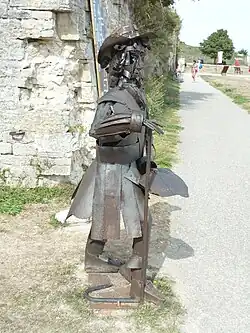 Marshal Vauban.
Marshal Vauban. -
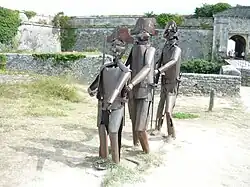 The patrol.
The patrol.
Description
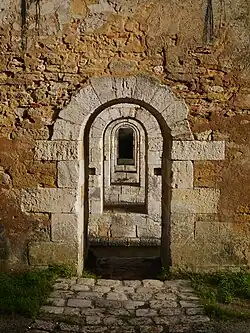
Situated on elevated terrain overlooking the Atlantic Ocean and the low-lying marshes of Ors, the citadel reflects construction phases from 1630 to 1704 under Louis XIII and Louis XIV. Despite significant damage during World War II, it retains several bastions, casemates, and buildings.[6]
The Royal Gate, likely built around 1640, features arms attributed to Cardinal Richelieu and is preceded by a fixed bridge and a demi-lune. The main courtyard centers on the arsenal, a 17th-century longitudinal building with multiple functions: an arsenal, provisions store, flour store, and chapel. To the right of the gate lies the governor's residence. Flanking the arsenal are the Bastion de la Brèche and Bastion Royal, both used for thematic exhibitions, including one on New France soldiers.[11] An isolated powder magazine stands south of the main entrance.
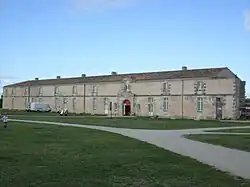
-
The Royal Gate.
-
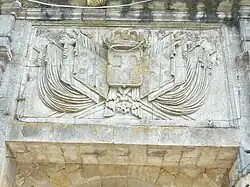 Pediment: Coat of arms with three defaced fleurs-de-lis. Ornaments: royal crown, standards, and Legion of Honour symbols.
Pediment: Coat of arms with three defaced fleurs-de-lis. Ornaments: royal crown, standards, and Legion of Honour symbols.
See also
- Citadel
- Vauban
- Cardinal Richelieu
- Île d'Oléron
- New France
- French Wars of Religion
- Monument historique (France)
References
- ^ a b c "Eglise Saint-Pierre-ès-Liens" [Saint-Pierre-ès-Liens Church]. pop.culture.gouv.fr (in French). Archived from the original on August 12, 2020. Retrieved July 14, 2025.
- ^ Demonfaucon, Cédric (2004). L'île d'Oléron [The island of Oléron] (in French). Editions Sutton. p. 96. ISBN 978-2849101117.
- ^ d'Aubigné, Agrippa (1854). Mémoires de Théodore Agrippa d'Aubigné [Memoirs of Théodore Agrippa d’Aubigné] (in French). Paris: Librairie de la Bibliothèque du Louvre.
- ^ "Forts et citadelles du littoral de Charente-Maritime" [Forts and citadels of the Charente-Maritime coast] (PDF). Charente-Maritime (in French). Archived from the original (PDF) on 2006-11-17. Retrieved 2025-07-14.
- ^ "Île d'Oléron : La Citadelle du Château d'Oléron" [Île d'Oléron: The Citadel of Château d'Oléron]. Oléron Story (in French). Archived from the original on September 7, 2006. Retrieved July 14, 2025.
- ^ a b c Lepage, Jean-Denis (2009). Vauban and the French Military Under Louis XIV. Jefferson, NC: McFarland & Company. ISBN 978-0786444014.
- ^ Greer, Allan (1997). The People of New France. Toronto: University of Toronto Press. ISBN 978-0802078162.
- ^ "La citadelle du Château-d'Oléron" [The Citadel of Château-d'Oléron]. Chapiteaux (in French). Archived from the original on February 14, 2008. Retrieved July 14, 2025.
- ^ Bodin, Jacques (1993). L'histoire extraordinaire des soldats de la Nouvelle France : gouvernement, vie en garnison et campagnes militaires en Acadie, au Canada et en Louisiane aux 17e et 18e siècles [The extraordinary history of the soldiers of New France: government, garrison life, and military campaigns in Acadia, Canada, and Louisiana in the 17th and 18th centuries] (in French). Ed. O.C.A. communication. ISBN 978-2-9508086-0-8.
- ^ Vergnol, Yvon (25 June 2014). "Des sculptures étranges à la Citadelle" [Strange sculptures at the Citadel]. SudOuest.fr (in French). Retrieved November 10, 2016.
- ^ "Découvrez les fortifications de Charente-Maritime" [Discover the fortifications of Charente-Maritime]. Camping Les Flots-Atlantique (in French). Retrieved July 14, 2025.